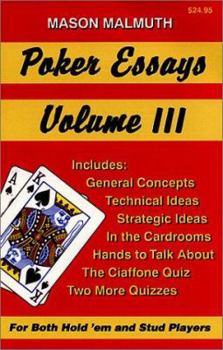Poker Essays, Volume III
Select Format
Select Condition 
Book Overview
Poker is a game which many people play, but in which few excel. To be successful requires a great deal of work and study, and a deep understanding of those concepts that govern winning play. Yet it is... This description may be from another edition of this product.
Format:Paperback
Language:English
ISBN:1880685272
ISBN13:9781880685273
Release Date:January 2022
Publisher:Two Plus Two Pub.
Length:270 Pages
Weight:0.99 lbs.
Dimensions:0.8" x 5.6" x 8.4"
Customer Reviews
2 ratings
For serious players, Malmuth is always worth reading
Published by Thriftbooks.com User , 17 years ago
This is the third collection of Malmuth's poker essays, and like the other two is interesting to read and full of valuable information. It is also more recent that the other two volumes (see my reviews) with a copyright date of 2001. Much is the same with the quizzes on hands played, discussions of the differences between hold'em and stud, and strategy considerations in various games, and Malmuth's signature section, "In the Cardrooms" in which he writes about cardroom problems, gives suggestions, etc. Here he delves into possible collusion in the games and gives some advice on how to keep the games honest. In this respect I recently read Dirty Poker (2006) in which cheating in poker is examined at length, although by a writer (Richard Marcus) who is not a regular player. Here Malmuth with an assist from David Sklansky makes it clear that collusion in the cardrooms he plays in is unlikely and certainly couldn't last long. A good point he and Sklansky make is that it is not all that easy for two players to successfully scam a game, and more players working together would be fairly obvious to the regulars. I believe they are correct, and my experience over the years has been about the same as Malmuth's who says he has never encountered collusion in the clubs. I believe I did once, in the early nineties at a ten and twenty game at a club in the Los Angeles area. The betting pattern was not just obvious, but glaringly obvious. I got up, and before leaving and never returning, said something to the floorman. I don't know what the result was. Possible collusion on the Internet is another matter, however. Which brings me to the weakness of this book for the contemporary player, which is the dearth of writing about Internet games. I hope Malmuth is currently playing on the Internet and is writing some essays about that experience that will appear in his next collection. One of the more interesting essays is "Which Is Bigger?" (stud or hold'em). Malmuth and "an associate" compared records at the $20/$40 level and discovered to their surprise that they had a larger variance at stud. Malmuth's explanation is a bit convoluted but seems essentially right. However, his statement "the bigger the standard deviation, the bigger the game" is true only if the games are the same size. The fact that they had an hourly standard deviation of $280 for the hold'em game and $350 for the stud game is not a reflection of more action at the stud game but is a direct result of the fact that stud and hold'em games with the same betting limits are not equal in size. Because there is an extra betting round (a Big Bet betting round) the stud game is bigger. Malmuth dances around this most salient point when he should make it clear that that extra double bet round is the real difference and not because he and his associate as expert stud players have learned to play looser. (Their relatively small S.D. suggests otherwise!) The way to figure the standard dev
Best in the series, maybe one of the best poker books ever.
Published by Thriftbooks.com User , 21 years ago
I got this book two days ago, and have already read it twice. It came highly recommended by a winning player in my ...10/20 stud game, and I haven't been disappointed.The essays are taken from Malmuth's writings in Poker Digest and other magazines over the past few years, as with the first two volumes. I thought the first volume was excellent, and the second was very good. This is by far the best.Poker Essays III, in my opinion, now joins "The Theory of Poker", "Super System", and the "for Advanced Players" series on the list of the most important poker books.As usual, Malmuth succeeds admirably in forcing the reader to think about many aspects of their game most players are usually unaware of. He discusses, for example, specific flaws in many average players who overrate their own abilities. And the last two sections are wonderful additions to this volume: "Hands to Talk About", and then quizzes. The "Hands" section discusses specific hands/situations in depth, to try to bring together all poker ideas into making a decision. The quizzes section includes two of his own, one hold'em and one stud, and one previously published by Bob Ciaffone (whose book "Improve Your Poker" is also on my short list of great poker books). There are 50+ essays in the book, and I found all of them interesting, thought-provoking and relevant. One of the things I like best about Malmuth is that he finds topics to write about that are completely ignored or forgotten by most players but that are either directly or indirectly relevant to winning play.As with Poker Essays I and II, I'm sure I'll be rereading this book several times over the years.




